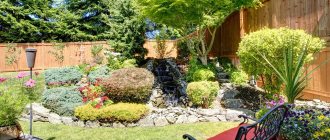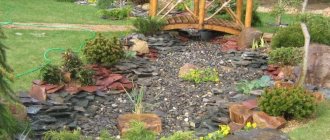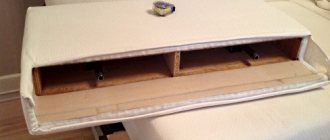Let's find out in more detail what flower lawns exist and what their pros and cons are.
The information from this article will allow you to create flower-strewn lawns at your summer cottage with your own hands. You will become familiar with the intricacies of selecting and sowing grass mixtures and the features of caring for ornamental lawns.
Moorish lawn, photo
What is Moorish lawn?
Several centuries ago, during the reign of the Moors, many areas intensively developed on the African continent and in Spain: architecture, science, etc. This period also saw the active development of landscape decor. Luxurious architectural buildings, palace complexes and picturesque parks - all this splendor was built in those distant years.
The Moorish lawn with meadow grasses formed the basis of luxurious gardens, striking the imagination with their beauty, located within the palace complexes.
In the palace parks, the Moors embodied the idea of a lawn with flowers, similar to a meadow landscape, but being an integral part of the landscape composition. Residents of European countries borrowed the idea of their southern neighbors to decorate lawns with flowering plants that grew mainly in meadows.
In addition to cereals and lawn grasses, the Moorish lawn usually includes 10-15 species of beautifully flowering low-growing annuals: gum, red and blue flax, cornflowers, poppies, daisies, etc.
The main advantage of using Moorish lawns in landscape design is that they look very beautiful and require a minimum of maintenance.
If you want to decorate your garden area, but are not eager to spend time regularly mowing and caring for a classic lawn, sow a mixture of flowers. In stores you can buy ready-made herbs (such mixtures have different names). In most cases, they include herbs and cereals (from 70 to 90%) and various flowering plants (about 10-30%).
You can make your own herbal mixture. Lawn grass is used as a base, and flowers that you like are added to it.
Recommendation: follow the proportions when preparing a mixture of herbs for decorating a Moorish lawn at your summer cottage.
The composition of the grass mixture will determine the appearance of the lawn, the flowering period of the grasses and the durability of the flower lawn.
Moorish lawns come in different types:
- containing tall vegetation;
- low, decorated with low plants;
- monochrome, including, in addition to greenery, flowers of the same variety and color;
- multi-colored - from a variegated mixture of cereal crops and various flowering vegetation.
Moorish lawns are the highlight of the oriental gardens and parks that amaze with their splendor.
Vegetation for arranging a flowering lawn should be selected in such a way that it has different flowering periods, otherwise the lawn will delight you with its beautiful design for a short time.
To get a clearer picture of how a Moorish-style lawn will look, look at photos of gardens that have such lawns. Variegated colors are appropriate in gardens decorated in an oriental or country style.
A man-made meadow in the design of a garden looks very impressive. The design of the site will look even more beautiful if you install a gazebo on such a lawn.
When arranging a Moorish lawn area, a lawn border tape will certainly come in handy - a useful thing for distinguishing between different plantings and preventing soil erosion.
The features of decorating flower beds along the paths are described in this article.
Recommendations for using lawn in landscape design
There are a number of tips that will help keep your lawn looking attractive and prevent it from overgrowing and drying out:
- Timely and correct haircut. It is not recommended to cut the grass very short. Haircut frequency: up to 2 times a week (more often in summer, less often in autumn). Before the procedure, it is recommended to comb the grass to avoid the growth of weeds.
- Aeration of the soil, due to which it is enriched with oxygen. For this, a rake or special fork is used.
- Timely and moderate watering. The procedure is carried out only in the evening using a spray. Puddles should not be allowed to appear, as they contribute to plant rotting.
- Feeding. Fertilizers are applied after each cutting, and their type depends on the type of seeds planted.
- Regular correction of the boundaries of the planting, which will give it the desired appearance.
The lawn on the site gives the impression of order, and well-groomed plants perfectly complement the landscape.
Lawn mowing
Lawn aeration
Combing the lawn
There are many photos of the design of lawns in front of the house, where you can see popular and exclusive options. The use of different grasses, thoughtful design and care will allow you to enjoy the beauty of the lawn for a long time, play on soft grass with children or host various events.
Advantages and disadvantages of Moorish style lawns
If you compare the Moorish lawn with a traditional lawn, it turns out that floral garden design has many more pros than cons.
In addition to the fact that such a lawn looks colorful and presentable, it has the following positive features:
- Does not need constant haircuts . Two haircuts per season will be enough. It is better to trim the Moorish lawn for the first time in the spring, when cereal crops begin to actively grow, and perennial plants and flowers have just sprouted. The second time such a lawn is mowed is in the fall, after the flowering period of most plants has ended and the seeds have fallen.
- Does not require constant care ; Agrotechnical work is carried out to a minimum.
- From one month to the next, the number of certain plants naturally changes , causing the lawn to look different. Vegetation is more easily renewed due to the fact that in the intervals between adjusting its height, the seeds have time to ripen and disperse.
- If bald spots appear on the lawn, it is easy to level them out by planting seedlings of annual plants or sowing fast-growing flowering crops.
- Able to grow on scanty, poor soils , for this you only need to periodically feed the plants.
A Moorish-style lawn can be combined with a classic lawn.
Despite the obvious advantages, this coating also has disadvantages:
- When making your own herbal mixture, you need to carefully consider its composition. If the mixture is not prepared correctly, there is a high probability that some plants will prevent the growth of others, some of the vegetation will not tolerate low temperatures in winter, and the lawn will not look aesthetically pleasing.
- Such a coating performs only a decorative function. Landscape decor with a Moorish-style lawn is not intended for games and picnics, as the flowers are easily damaged and trampled.
- Lawns that occupy a large area take a lot of time to maintain. On large sites, the likelihood increases that the vegetation will no longer be controllable and will transform into an unkempt meadow. For this reason, flowering herbs are planted in small islands.
Important! When creating a mixture of grasses for your lawn, take into account the height of the vegetation, its flowering period and frost resistance.
Creating a floral design
Creating a piece of a beautiful oriental-style garden on your own backyard is a realistically feasible task. To successfully implement this idea, you need to choose the right vegetation and follow the recommendations for creating a flower lawn.
How to select plants for a presentable combination? If you decide to arrange a flowering meadow in the Moorish style yourself, the first thing you need to do is to choose the right varieties of herbs and flowers suitable for your garden.
Tip: choose perennials that do not suffer from proximity to plants of other species.
Annual plants that delight with their flowering for one season should be selected that produce seeds without problems, self-disperse, and sprout in the spring at the same time.
What types of plants do Moorish lawns include? Remember that this is still a lawn, albeit a flowery one, and not a flower bed. Most of it should be sown with cereal crops.
Some of the most popular types of grasses suitable for mid-latitudes include the following:
- meadow bluegrass;
- fragrant bison;
- red blooming fescue;
- meadow timothy.
Cereals in the grass mixture should occupy from 70 to 90%. If you do not have experience creating flower lawns, choose mixtures consisting of 85% lawn grass varieties. A lawn with a large number of plants is more difficult to maintain.
Choosing a form
Remember that the presence of a lawn will no longer surprise anyone, but its interesting shape and beautifully designed edges are more important for perception.
- very boring and dull , repeating the lines of the fence of the site and not adding any variety. But it is precisely when creating such an element of landscape design as a lawn that you can give free rein to your imagination .
If you are still a fan of straight lines and like the rectangular shape, then you can add originality . An L-shaped line surrounding a patio or a bright, contrasting flower bed will easily cope with this task.
PhotoMIX-Company / Personal archive
The most popular annual and perennial plants
Flowering vegetation is chosen so that different varieties bloom at different times. In spring, bulbous plants and early varieties of perennials will delight with variegated colors, after which annual flowers will bloom, creating an aesthetic picture for almost the entire season.
The most popular annual plants suitable for Moorish lawns include the following:
- self-dispersing field poppy;
- marigold;
- various types of cornflowers;
- chamomile;
- low types of cosmos;
- flax with large flowers.
On a note! Cosmea harmonizes perfectly with cereal crops.
A distinctive feature of these species is their ability to randomly disperse seeds. This eliminates the need to regularly plant new vegetation - the cover is renewed naturally.
The most popular perennial plants for the Moorish lawn:
- echinacea;
- meadow nivaria;
- perennial varieties of gypsophila;
- Lavender angustifolia.
All of these plants are unpretentious and can easily tolerate mowing.
Early bulbous varieties for Moorish-style lawns:
- tulips;
- cockerels;
- daffodils;
- various types of decorative onions;
- crocuses.
The photo below shows an example of a Moorish lawn made of bulbous flowering plants:
Subtleties of landing
Let's figure out what is the difference between planting a traditional lawn and creating a Moorish-style lawn. A site for a flower carpet should be selected with good lighting, since in areas shaded by trees or buildings it is difficult to create a thick covering of ornamental plants.
When considering how to properly create a Moorish lawn, you need to first think about when to plant the grass mixture. In this case, the characteristics of the plants that make up the lawn should be taken into account. For example, it is better to sow a herbal mixture consisting of intensively growing cereal crops and annual plants in early spring, while perennial bulbous varieties should be planted in the fall.
Look how beautiful the variegated forbs look in the photo:
Spring sowing
Moorish lawn seeding should be done in windless conditions. The soil should be slightly moist, but not dry or flooded.
How to plant a Moorish lawn in spring? Let's look at the step-by-step sowing of plants:
- If the area needs to be cleared of weeds, this work should be done in the fall. Be sure to remove all wild grass roots and treat the soil with herbicides. Remove 8-10 cm of soil to remove all weed roots and seeds.
- With the arrival of spring, when the ground thaws and dries, dig it up with a shovel. If the soil is fertile, additional fertilizer is not necessary. Add 50-60 grams to poor soil during digging. fertilizers based on phosphorus and nitrogen per square meter.
- Sowing begins in the second decade of April or early May, depending on climatic conditions. Before planting the seeds, the soil is leveled with a rake and compacted.
- To distribute the seeds evenly, the herbal mixture is mixed with sand in a ratio of 1:3 (sand should be used dry). The prepared mixture is sown in the prepared soil.
- To plant seeds in the ground, use a rake, making short strokes, as when weeding. The immersion depth of the seeds is 1-2 cm. After this, the soil is compacted with a roller.
- Agrofibre serves as a protective covering for the lawn. It is also necessary to install sprinklers for irrigation. The soil needs regular moistening. After the first shoots appear, the covering fabric is removed.
Sowing in autumn
Planting in the autumn is done so that perennial plants and bulbous varieties have time to take root before spring. The period for laying a lawn occurs at the end of summer and beginning of autumn, before the cold weather sets in.
Step by step planting:
- Before planting a Moorish lawn in the autumn, a couple of weeks before sowing the plants, the area must be cleared of weeds and dug up. Poor soils are enriched with complex additives at the rate of 60-70 g. per one square meter.
- Right before planting, weeds are removed again and then the soil is leveled with a rake.
- First of all, shrubby perennial plants and bulbous varieties are planted. It is recommended to place small plants in groups of 5 or in islands. After planting, the soil is loosened again and leveled with a rake.
- The area that remains unplanted is sown with a herbal mixture (30-50 grams per square of land). The seeds are immersed in the soil with a rake and then compacted with a roller.
- Humidity is usually high in autumn, so there is little need for additional irrigation. If there is no rain, the lawn is irrigated with sprinklers.
Features of care
Despite the fact that lawns decorated with flowering vegetation look extremely natural, they also need care.
Only with proper care does the covering of herbs and flowers acquire the most attractive appearance. What are the features of caring for a Moorish lawn? Considering that meadows decorated with meadow flowers can be either perennial or annual, their agricultural maintenance may be different. First of all, this applies to adjusting the height of the coating; other activities related to lawn care are almost identical.
Selecting a location
Choosing a place for a beautiful lawn takes into account the amount of sunlight, the type of soil and its moisture content. On most sites it is not possible to choose the ideal place, but there is always the opportunity to complete what nature did not provide. The main thing is to study what is already available and take appropriate measures.
- Location relative to cardinal directions. The amount of sunlight hitting your beautiful lawn depends on which direction it faces. Please note: cold winds most often blow from the east or north. Dank damp ones - from the west and southwest. Therefore, a garden facing south will receive more hot sun, and one facing north will receive excess shade.
- Terrain. A beautiful green lawn planted on a slope does not tolerate strong winds. Smooth, on the contrary, but here there is a possibility of deep shadow, excess moisture, or vice versa: a lot of light and little water.
Autumn still life Source www.goodfon.ru
Advice! Lawns laid out in the sun require special care: abundant watering and not too short trimming (shade from the leaves protects the roots from drying out).
- Shade and lack of moisture. Grass planted close to buildings and fences will lack moisture. This happens due to the so-called “rain shadow”, since in most cases the drops fall at a slight angle. A similar situation occurs on lawns where garden trees cast shadows. The leaves on the lawn become pale in color and follow the sun, becoming an easy victim of fungal diseases. In autumn, under a layer of fallen leaves, they lack light, which also leads to the appearance of harmful microorganisms.
See also: Catalog of companies that specialize in landscaping work on sites.
How to do a haircut correctly
A perennial Moorish-style lawn is cut or mowed twice per season. The first mowing is done after the cereal crops have risen: the cutting is carried out in order to create the same conditions for the growth of vegetation of different types.
But this is done only in the first year; in subsequent years, the lawn is cut in late spring - early summer, and also after the seeds have ripened and scattered - in mid-autumn. If plant growth is intense, most likely you will have to cut the clearing a second time at the end of summer. The height adjustment is made by 8-12 cm.
A clearing containing bulbous varieties is trimmed only after their leaves are completely dry. This is required so that the plant bulbs can stock up on nutrients for the winter.
The Moorish lawn, consisting of annual plants, is first cut before the flowers rise, and cut again after the seeds have dispersed. The timing of adjusting the height of the cover may vary and depend on certain plant varieties. You need to monitor the condition of the lawn and adapt to the growth stages of the flowers.
Throughout the growing season, it is necessary to monitor so that the artificial meadow is not overrun by weeds. Harmful plants have to be removed manually. Weeding with a hoe or using herbicides is not permissible, as this will damage all ornamental vegetation.
Functions of fencing
First of all, you need to decide why you need a fence. Are we protecting the lawn or are we protecting ourselves from the lawn? Do you need physical access restrictions or just decoration? Do we want to isolate one zone from another?
Here are the main functions of fencing:
- decorative design;
- restricting access to the fenced area (strangers, children, animals, etc.);
- obstacle to vegetation;
- delimitation of functional zones of the site (for example, playground and recreation area);
- fence for safety (for example, at the edge of the terrace).
Having thought about why you need a fence, study what options are available and choose or invent your own!
Irrigation and fertilizing rules
In the first twenty days after planting, you need to especially carefully monitor the soil moisture.
Important! Don't let the soil dry out, especially if it's hot outside. Even a short drought can damage germinating seeds and destroy seedlings.
Irrigation can be reduced only after seedlings of all types of plants appear on the lawn. Small lawns can be irrigated using a sprinkler with a fine sieve. In large areas, it is more convenient to install sprinklers or use drip irrigation systems.
Clearings dotted with flowers require almost no feeding. If the vegetation begins to wither, fertilizing additives are added during the next irrigation. For this purpose, urea, saltpeter and ammonia are spread throughout the area at the rate of 10-20 g. per square meter of land. Stores also sell complex fertilizer additives for flowering lawns. Before using them, you should read the instructions on the packaging.
Defining the goal
Before you install and remodel your lawn, you must understand why you need it.
pxhere.com Alexei 1606530 / Personal archive
- If children and animals will constantly play on the lawn, sow appropriate hardy grasses .
- If you admire the lawn from the outside and can provide it with regular and careful care, you can pamper yourself with a parterre lawn with rare meadow grasses.
Jeremy Page/Flickr.com
Decoration options
There are many ways to combine plants. Among the ready-made herbal mixtures there are mixes consisting of 10-15 cereal crops and several dozen varieties of flowers. If you want to make your own mixture, it is recommended to use proven combinations.
To create an annual Moorish lawn, a meadow variety of mint, red-blooming fescue, and flax with large flowers are suitable.
Lawns decorated in a rustic style look like wild meadows.
For a perennial meadow, fragrant bison, crocuses, cockerels, narrow-leaved lavender, and lupine are suitable.
The photo below shows a Moorish lawn in a rustic style:
To prevent the lawn from losing its presentable appearance during the intervals between the flowering of perennial plants, a small amount of seeds of annual flowers, for example, calendula or low cosmos, can be included in the herbal mixture.
Read about how to create a beautiful blooming rose garden at your dacha with your own hands: photos and placement diagrams of shrubs, criteria for choosing rose varieties for original flower beds.
You can see photos of fast-growing hedge plants in the article here.
A list of garden perennial flowers that bloom all summer is in the article at:
With proper care, a flowering lawn will delight the eye for several years. Decorating a lawn in a Moorish style will add some zest to the landscape decor of your summer cottage.
Non-standard forms
- Smooth, winding lines will also look beautiful Such lawns are ideally combined with ribbon flower beds, island flower beds and landscape plantings.
Gray Rocker / Flickr.com
- An interesting and non-standard solution would be to change the level of the lawn in certain areas. This will look especially impressive The difference in height level can be 15-25 cm.
DrNickStafford / Personal archive
- The lawn can be raised or, conversely, “ submerged .” Such a lawn will require mandatory border design and a thoughtful approach to the lawn mower. Stone or brickwork will look beautiful and stylish in this role . Such an element of garden decoration will definitely not go unnoticed.











